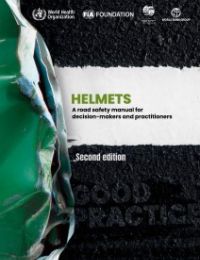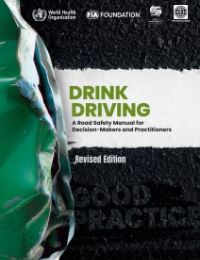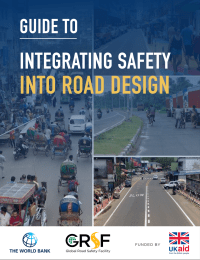Publications
1-10 of 12
-
-
Road Users
Drink-Driving: A Road Safety Manual for Decision-Makers and Practitioners (2nd ed.)
November 2022
-
-
- international literature and good practices on motorcycle safety;
- assessment of motorcycle crashes, regulations, risk exposure data, risk indicators in African countries (with more detailed analysis of Burkina Faso, Cameroon, Rwanda, and Uganda); and
- consultations with stakeholders.
-
-
Road Infrastructure
Guide pour l’Intégration de la Sécurité dans la Conception des Routes (French)
July 2022
-
-
Road Infrastructure
Practical Guide for Road Safety Auditors and Inspectors in Ukraine (Ukrainian)
July 2022
-
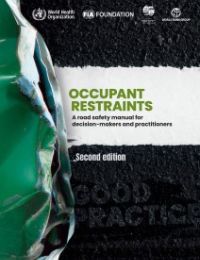
This manual provides guidance and evidence for decision-makers and practitioners that should lead to an increase in the use of vehicle occupant restraints, such as seat-belts for adults and car seats for babies and children. It draws on experience from countries that have succeeded in achieving and sustaining high levels of vehicle occupant restraint use, and builds on new evidence, including from low and middle-income countries.
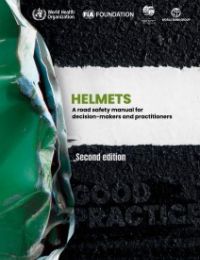
Safe, quality helmets reduce the risk of death in a road crash by over six times, and reduce the risk of brain injury by up to 74%. Head trauma is the leading cause of death for riders, and motorcycles continue to proliferate rapidly. Yet the use of helmets in many low and middle-income countries remains low.
The second edition of the Helmets Manual offers guidance to help decision makers and practitioners put in place the comprehensive set of laws, regulations and actions needed to increase the use of safe, quality helmets to save lives.
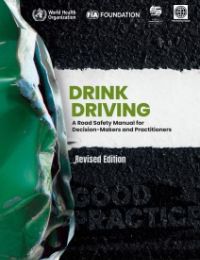
This manual provides guidance for decision-makers and practitioners to reduce the prevalence of drink driving and associated road trauma. It draws on experience from countries that have succeeded in achieving and sustaining reductions in alcohol-related road trauma, and includes recommendations for developing and implementing drink driving legislation, and advice on how to monitor and evaluate progress.

Walking is a predominant mode of travel in Addis Ababa representing more than half of the daily trips. The mild climate in Addis Ababa is conducive for this healthy and green mode of transport. However, sidewalks are often narrow, uneven, obstructed, or non-existent, causing discomfort and road safety risks to the most vulnerable road users: pedestrians. Studies done by the WHO and the Government showed that AA has disproportionately high pedestrian fatalities.
The study on Addis Ababa Sidewalk Safety and Improvement takes the approach of integrating digital technology and Urban Inventory in sidewalk surveys, applies the Global Walkability Index in sidewalk assessments, and adapts the global best practice to the local context. The Addis Ababa Sidewalk Design and Maintenance Guidelines seek to promote the development of quality pedestrian infrastructure and environments, based on the condition’s assessment and global best practices. The design specifications and visual rendering provide recommendations for the policy makers to consider when developing the City’s design and maintenance standards for urban roads, sidewalks, public spaces, and transit-oriented development, some of which are being carried out as part of the technical assistance program of the World-Bank financed Transport Systems Improvement Project (TRANSIP).

In developing countries with inadequate public transport and road infrastructure, motorcycles present a fast, cheap, and efficient transport alternative. Motorcycles are widely used in many African countries for personal and public transport, as well as for service delivery. In some African countries, motorized two and three-wheelers constitute the largest proportion of the motorized vehicle population. However, despite their benefits, motorcycles expose their riders and passengers to a high risk of serious injury or death in the event of crashes. Motorcycle safety is therefore a significant problem in Africa. On average, 22.5% of road traffic deaths in 2016 involved riders/passengers of two- and three-wheelers, according to the last data published by World Health Organization (WHO, 2018).
This research study presents comprehensive strategic recommendations on how to improve motorcycle safety in Africa. The study will serve as policy advice and technical assistance to the Bank’s regional member countries (RMCs). The study focuses on motorcycle safety conditions in Cameroon, Burkina Faso, Rwanda, and Uganda, where the use of motorcycles for daily activities is reputedly high. Recommendations are predicated on an examination of the major causes of motorcycle crashes and injuries, as well as an extensive body of knowledge from various sources, notably:
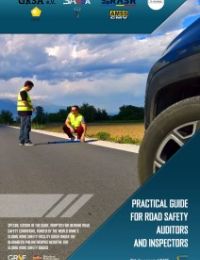
After almost two decades of experience with Road Safety Audit (RSA) Worldwide, this procedure is now recognized as one of the most efficient engineering tools. RSA is a highly efficient and cost-effective engineering tool for improvement of safety on roads. It is much cheaper to identify road safety deficiencies in the process of design than later after construction is completed. RSAs are among the most cost-effective investments a Road Authority can undertake.
With its EU Directive No. 2008/96 and amendment 2019/1936 on road infrastructure safety management, the European Union (EU) made a clear decision that RSA will be mandatory for the Trans-European Road Network (TERN) and main roads. This Directive contains another tool called Road Safety Inspection (RSI) on safety deficiencies of existing roads. The RSI is very similar to the process of Road Safety Audit in the pre-opening phase of newly constructed roads. RSIs are essential for the redesign and upgrading of existing roads, and these are done in many countries to give the designers insights and direction for safety improvements. Given that, the purpose of this practical guide is to provide practical guidance to those doing RSAs and RSIs, the examples of typical design deficiencies shown should be useful to both road safety inspectors and road safety auditors.
This document draws on the more comprehensive guidelines and manuals on Safety engineering mentioned in the acknowledgements but deliberately focuses only on these issues of direct relevance to road safety auditors/inspectors and to the road safety reports that they must prepare, including of recommendations for improvements.
This is a special edition of the guide, adapted for Ukraine road safety conditions and legislation, funded by the World Bank‘s Global Road Safety Facility (GRSF) under the Bloomberg Philanthropies Initiative for Global Road Safety (BIGRS).

Ce guide se concentre sur les éléments des conceptions de routes et de bordures de route sûres pour les réseaux routiers qui peuvent offrir une mobilité sûre à tous les usagers de la route.
Une réduction substantielle des décès sur les routes ne sera réalisable que si des efforts concertés sont déployés, en suivant l'approche du « Système sûr » impliquant tous les éléments de la sécurité routière, de la gestion et de la prestation. Cela inclut tous les piliers du Système sûr — à commencer par la gestion de la sécurité routière, les routes et bordures de route sûres, la vitesse sûre, les véhicules sûrs, les usagers de la route sûrs et les soins post-accident. Ce guide se concentre sur les éléments des conceptions de routes et de bordures de route sûres pour les réseaux routiers qui peuvent offrir une mobilité sûre à tous les usagers de la route, ainsi que sur les changements complémentaires pour améliorer les vitesses, la sécurité des véhicules, les comportements des usagers de la route et les soins post-accident. Une conception équilibrée des routes doit prendre en compte ces éléments complémentaires du système pour maximiser les avantages en termes de sécurité. L'énergie portée par un objet en mouvement est proportionnelle au carré de sa vitesse. Une « bordure de route indulgente » bien conçue garantit que cette énergie est dispersée en cas de collision et, par conséquent, moins d'énergie est transférée aux occupants.
La conception des infrastructures routières joue un rôle vital dans les résultats en matière de sécurité routière. Des infrastructures sûres soutiennent les autres piliers de la sécurité routière en encourageant un comportement approprié des usagers de la route (comme une vitesse appropriée et une position correcte sur la voie) et en offrant un environnement routier indulgent en cas d'erreur. Une infrastructure routière mal conçue peut entraîner des comportements dangereux des usagers de la route. Une des principales réalisations de l'approche du Système sûr est que les conducteurs font des erreurs et continueront à en faire, même si nous pouvons réduire leur fréquence. Cette erreur des usagers de la route a longtemps été reconnue comme un contributeur significatif aux mauvais résultats en matière de sécurité routière. Cependant, les routes, pour une vitesse donnée, peuvent être conçues pour réduire la probabilité de collisions, et il existe des preuves très claires que la gravité des résultats lorsque des collisions se produisent est significativement influencée par la conception de la route. Même si une collision se produit encore, une infrastructure routière améliorée peut sauver de nombreuses vies et prévenir des blessures débilitantes.
L'approche du Système sûr souligne qu'une réponse partagée est nécessaire pour aborder la sécurité routière. Cela signifie que les usagers de la route continueront à assumer la responsabilité de leurs actions, par exemple en étant vigilants et en respectant les règles de la route. Cependant, il est également reconnu que les gestionnaires et les concepteurs de routes ont une responsabilité significative de fournir un système routier qui protège tous les usagers de la route. Cela peut être réalisé grâce à des conceptions appropriées des routes.
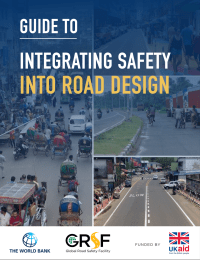
This guide focuses on elements of safe road and roadside designs for road networks that can provide safe mobility to all road users
A substantial reduction in road deaths will only be feasible if concerted efforts are made, following the “Safe System” approach involving all elements of road safety, management, and delivery. This includes all pillars of the Safe System—starting from road safety management, safe roads and roadsides, safe speed, safe vehicles, safe road users, and post-crash care. This guide focuses on elements of safe road and roadside designs for road networks that can provide safe mobility to all road users, as well as complementary changes to improve speeds, vehicle safety, road user behaviors, and post-crash care. A balanced road design must take into account these complementary system elements to maximize safety benefits. The energy carried by a moving object is proportional to the square of its speed. A well-designed “forgiving roadside” ensures that this energy is dispersed in a crash, and as a result, less energy is transferred to the occupants.
Road infrastructure design plays a vital role in road safety outcomes. Safe infrastructure supports other road safety pillars by encouraging appropriate road user behavior (such as appropriate speed and correct lane position) and by providing a forgiving road environment if things go wrong. Poorly designed road infrastructure can give rise to dangerous road user behavior. One of the key realizations of the Safe System approach is that drivers make mistakes and will continue to do so, even if we can reduce how often these occur. This road user error has long been recognized as a significant contributor to poor road safety outcomes. However, roads of any given speed can be designed to reduce the likelihood of crashes occurring, and there is very clear evidence that the severity of outcomes when crashes do occur is significantly influenced by the road design. Even if a crash still occurs, improved road infrastructure can save many lives and prevent debilitating injuries.
The Safe System approach highlights that a shared response is required to address road safety. This means that road users will continue to take responsibility for their actions, for instance by being alert and compliant with road rules. However, it is also recognized that road managers and designers have a significant responsibility to provide a road system that protects all road users. This can be achieved through appropriate designs of roads.

Після майже двох десятиліть досвіду проведення аудиту безпеки дорожнього руху (RSA) у всьому світі ця процедура визнана одним із найефективніших інженерних інструментів. RSA є високоефективним і економічно вигідним інженерним інструментом для підвищення безпеки на дорогах. Набагато дешевше виявити недоліки безпеки дорожнього руху в процесі проектування, ніж пізніше після завершення будівництва. RSA є одними з найбільш рентабельних інвестицій, які може здійснити дорожнє управління.
У своїй Директиві ЄС № 2008/96 і поправці 2019/1936 щодо управління безпекою дорожньої інфраструктури Європейський Союз (ЄС) прийняв чітке рішення про те, що RSA буде обов’язковим для Транс’європейської мережі доріг (TERN) і магістральних доріг. Ця Директива містить інший інструмент під назвою «Інспекція безпеки дорожнього руху» (RSI) щодо недоліків безпеки існуючих доріг. RSI дуже схожий на процес аудиту безпеки дорожнього руху на етапі перед відкриттям новозбудованих доріг. RSI мають важливе значення для редизайну та модернізації існуючих доріг, і вони проводяться в багатьох країнах, щоб дати проектувальникам зрозуміти та вказати напрямки для покращення безпеки. Враховуючи те, що метою цього практичного посібника є надання практичних вказівок тим, хто проводить RSA та RSI, наведені приклади типових недоліків конструкції мають бути корисними як інспекторам безпеки дорожнього руху, так і аудиторам безпеки дорожнього руху.
Цей документ спирається на більш вичерпні рекомендації та посібники з техніки безпеки, згадані у подяках, але навмисно зосереджується лише на тих питаннях, які мають безпосереднє відношення до аудиторів/інспекторів з безпеки дорожнього руху та до звітів з безпеки дорожнього руху, які вони повинні підготувати, включаючи рекомендації щодо покращення.
Це спеціальне видання посібника, адаптованого до умов безпеки дорожнього руху та законодавства в Україні, фінансованого Глобальним фондом безпеки дорожнього руху (GRSF) Світового банку в рамках Ініціативи Bloomberg Philanthropies for Global Road Safety (BIGRS).

Este guia se concentra em elementos de projetos de estradas e acostamentos seguros para redes rodoviárias que podem fornecer mobilidade segura a todos os usuários das estradas
Uma redução substancial nas mortes nas estradas só será viável se esforços conjuntos forem feitos, seguindo a abordagem do "Sistema Seguro" envolvendo todos os elementos de segurança rodoviária, gerenciamento e entrega. Isso inclui todos os pilares do Sistema Seguro — começando pelo gerenciamento de segurança rodoviária, estradas e acostamentos seguros, velocidade segura, veículos seguros, usuários seguros das estradas e cuidados pós-acidente. Este guia se concentra em elementos de projetos de estradas e acostamentos seguros para redes rodoviárias que podem fornecer mobilidade segura a todos os usuários das estradas, bem como mudanças complementares para melhorar as velocidades, a segurança dos veículos, os comportamentos dos usuários das estradas e os cuidados pós-acidente. Um projeto rodoviário equilibrado deve levar em consideração esses elementos complementares do sistema para maximizar os benefícios de segurança. A energia transportada por um objeto em movimento é proporcional ao quadrado de sua velocidade. Um "acostamento tolerante" bem projetado garante que essa energia seja dispersada em um acidente e, como resultado, menos energia seja transferida para os ocupantes.
O projeto de infraestrutura rodoviária desempenha um papel vital nos resultados de segurança rodoviária. A infraestrutura segura dá suporte a outros pilares da segurança viária, incentivando o comportamento adequado do usuário da estrada (como velocidade adequada e posição correta na faixa) e fornecendo um ambiente de estrada tolerante se as coisas derem errado. Uma infraestrutura rodoviária mal projetada pode dar origem a um comportamento perigoso do usuário da estrada. Uma das principais conclusões da abordagem do Sistema Seguro é que os motoristas cometem erros e continuarão a fazê-lo, mesmo que possamos reduzir a frequência com que ocorrem. Esse erro do usuário da estrada é há muito reconhecido como um contribuinte significativo para resultados ruins de segurança viária. No entanto, estradas de qualquer velocidade podem ser projetadas para reduzir a probabilidade de ocorrência de acidentes, e há evidências muito claras de que a gravidade dos resultados quando os acidentes ocorrem é significativamente influenciada pelo projeto da estrada. Mesmo que um acidente ainda ocorra, uma infraestrutura rodoviária melhorada pode salvar muitas vidas e evitar ferimentos debilitantes.
A abordagem do Sistema Seguro destaca que uma resposta compartilhada é necessária para abordar a segurança viária. Isso significa que os usuários da estrada continuarão a assumir a responsabilidade por suas ações, por exemplo, estando alertas e em conformidade com as regras de trânsito. No entanto, também é reconhecido que os gerentes e projetistas de estradas têm uma responsabilidade significativa de fornecer um sistema viário que proteja todos os usuários da estrada. Isto pode ser alcançado por meio de projetos de estradas apropriados.


